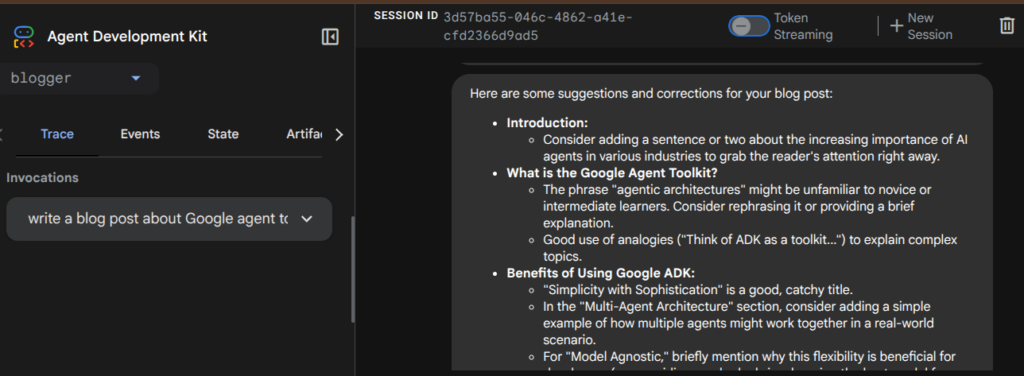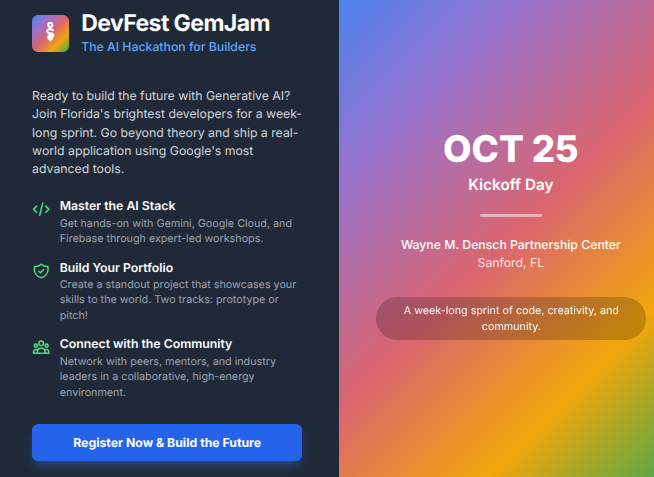
In the rapidly evolving landscape of AI-powered applications, Google has introduced the Agent Development Kit (ADK) – a powerful framework that democratizes the creation of sophisticated AI agent systems. If you’ve ever wanted to build intelligent workflows that can think, research, and iterate like human experts, the Google ADK might be exactly what you’re looking for.
What is the Google Agent Development Kit?
The Google Agent Development Kit is a Python framework that enables developers to create multi-agent systems powered by Google’s Gemini models. Think of it as a toolbox that lets you build teams of AI specialists, each with their own expertise, that can work together to solve complex problems.
Key Benefits of Google ADK
1. Simplified Agent Creation
Gone are the days of complex prompt engineering and manual API orchestration. With ADK, creating an AI agent is as simple as defining its purpose, providing instructions, and specifying the tools it needs. The framework handles the heavy lifting of model interaction and context management.
2. Powerful Composition Patterns
ADK supports multiple agent orchestration patterns, including:
– Sequential Agents: Execute tasks in a predetermined order
– Parallel Agents: Run multiple agents simultaneously
– Conditional Workflows: Route tasks based on dynamic conditions
3. Built-in Tool Integration
Agents can leverage pre-built tools like Google Search, or you can create custom tools to extend functionality. This means your agents can access real-world data and services, not just generate text.
4. Production-Ready Infrastructure
With built-in session management, runners, and error handling, ADK provides the foundation for deploying agent systems in production environments.
5. Cost-Effective Development
By breaking complex tasks into specialized agents, you can optimize model usage and reduce costs. Each agent uses only the capabilities it needs for its specific role.
Key Concepts in Google ADK
Agents
The fundamental building block of ADK is the Agent class. Each agent is a specialized AI assistant with:
– A specific name and description
– Clear instructions defining its role
– Access to tools for external capabilities
– An output_key for result organization
Tools
Tools extend agent capabilities beyond text generation. The google_search tool, for example, allows agents to access current information from the web, making them more useful for research and fact-checking tasks.
Sequential Agents
The SequentialAgent class enables you to chain multiple agents together, where each agent’s output becomes input for the next. This creates powerful processing pipelines that can handle complex, multi-step workflows.
Session Management
ADK includes InMemorySessionService and other session management options to maintain context across agent interactions, enabling sophisticated conversational flows.
Code Teardown: A Blog Writing Pipeline
Let’s examine a real-world implementation that demonstrates these concepts in action – a complete blog writing pipeline that mimics how professional content teams work:
The Agent Team Structure
from google.adk.agents import Agent, SequentialAgent
from google.adk.tools import google_search
The system imports the core ADK components and the Google Search tool, establishing the foundation for our agent pipeline.
1. The Writer Agent
blogger_writer_agent = Agent(
name="blogger_writer_agent",
model="gemini-2.0-flash",
description="Agent to write a 600 word blog post about a focused topic.",
instruction="""
I can write a detailed 600 word blog post on any focused topic you provide.
Just give me the topic and I'll create the content for you!
I will try to use real world case studies or stories to increase engagement.
**Quality elements for blog post**
- Compelling Title: Grabs attention immediately.
- Lead Paragraph: Hooks the reader with relevance.
- Personal Experience: Builds connection through storytelling.
- Main Body: Scannable content with lists and bullets.
- Discussion Question: Invites reader interaction.
""",
tools=[google_search],
output_key="blog_content"
)
This agent serves as the primary content creator. Notice how the instructions are detailed and specific, providing clear quality guidelines. The google_search tool enables the agent to research current information, and the output_key ensures the generated content is properly captured for the next stage.
2. The Review Agents
blogger_review_agent = Agent(
name="blogger_review_agent",
model="gemini-2.0-flash",
description="Agent to review blog content for quality and accuracy.",
instruction="""
I can review your blog content and provide feedback on quality and accuracy.
You are focused on novice or intermediate learners.
Just provide me with the content and I'll outline corrections and suggestions as bullets.
**Blog Content to Review:**
{blog_content}
""",
tools=[google_search],
output_key="review_comments"
)

The review agent acts as an editor, analyzing the content and providing structured feedback. The instruction template {blog_content} demonstrates how agents can reference outputs from previous stages in the pipeline.
3. The Revision Agent
blogger_revise_agent = Agent(
name="blogger_revise_agent",
model="gemini-2.0-flash",
description="Agent to revise blog content based on review comments.",
instruction="""
I can help you revise your blog content based on the feedback provided.
Just give me the original content and the review comments, and I'll make the necessary changes.
Return content as markdown.
**Original Blog Content:**
{blog_content}
**Review Comments:**
{review_comments}
""",
tools=[google_search],
output_key="blog_content"
)
This agent takes both the original content and review feedback to produce an improved version. Notice how it references multiple previous outputs ({blog_content} and {review_comments}), demonstrating the powerful data flow capabilities of ADK.
4. The Pipeline Orchestration
blog_pipeline_agent = SequentialAgent(
name="BlogPipelineAgent",
sub_agents=[
blogger_writer_agent,
blogger_review_agent,
blogger_revise_agent
],
description="Executes a sequence of blog writing, reviewing, and revising."
)
The SequentialAgent ties everything together, creating a complete workflow that:
1. Writes initial content
2. Reviews it for quality
3. Revises based on feedback
4. Performs a second review cycle
5. Makes final revisions
This multi-pass approach ensures high-quality output through iterative improvement, similar to how human editorial teams work.
You can find the complete source code for this agent on my public repo: LLM Power Tools/blogger sample
Real-World Applications
This blog writing pipeline demonstrates patterns applicable to many domains:
- Legal Document Review: Research → Draft → Review → Revise
- Technical Documentation: Outline → Write → Fact-check → Polish
- Marketing Campaigns: Strategy → Content → Review → Optimize
- Research Reports: Gather → Analyze → Synthesize → Validate
Best Practices Observed
1. Clear Role Definition
Each agent has a specific, well-defined purpose. This specialization leads to better results than trying to create one “super-agent” that does everything.
2. Quality Guidelines
The writer agent includes explicit quality criteria in its instructions, ensuring consistent output standards.
3. Iterative Improvement
The pipeline includes multiple review and revision cycles, mimicking professional content creation workflows.
4. Tool Integration
All agents have access to Google Search, ensuring they can validate facts and incorporate current information.
5. Structured Output
Using consistent output_key values enables smooth data flow between agents.
Getting Started
To begin building with Google ADK:
- Install the SDK: Add the Google ADK to your Python environment
- Define Your Workflow: Break down your problem into discrete agent roles
- Create Specialized Agents: Build agents with clear instructions and appropriate tools
- Orchestrate with Sequential or Parallel Patterns: Chain agents together based on your workflow needs
- Test and Iterate: Refine agent instructions based on output quality
The Future of AI Workflows
Google’s Agent Development Kit represents a significant step toward making sophisticated AI workflows accessible to everyday developers. By providing high-level abstractions for agent creation and orchestration, ADK enables teams to focus on business logic rather than infrastructure concerns.
As AI becomes more integrated into business processes, frameworks like ADK will be essential for creating reliable, maintainable, and scalable AI systems. The blog pipeline we examined is just one example – imagine similar patterns applied to customer service, data analysis, creative workflows, and countless other domains.
What’s Next?
The example we’ve explored demonstrates the power of sequential agent workflows, but Google ADK offers much more. Consider experimenting with:
– Custom tools for domain-specific capabilities
– Parallel agent execution for performance optimization
– Conditional routing for dynamic workflows
– Integration with external systems and APIs
The future of software development increasingly involves orchestrating teams of AI agents, and Google’s Agent Development Kit provides an excellent foundation for that journey.
Have you experimented with multi-agent AI systems? What workflows in your organization could benefit from the agent orchestration patterns we’ve discussed? Share your thoughts and experiences in the comments below.

Learn more at DevFestFlorida.com
Leave a Reply